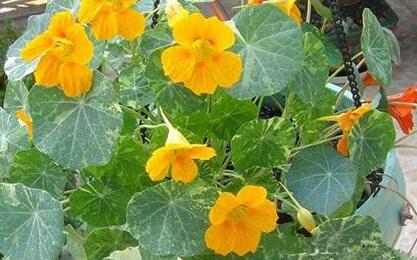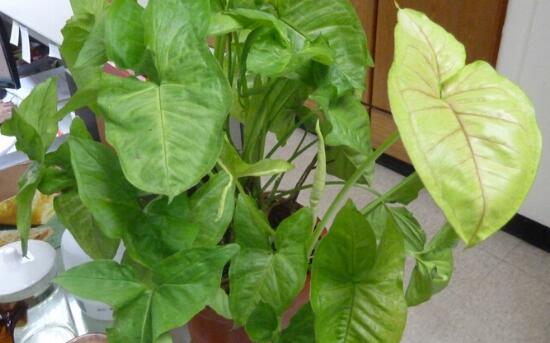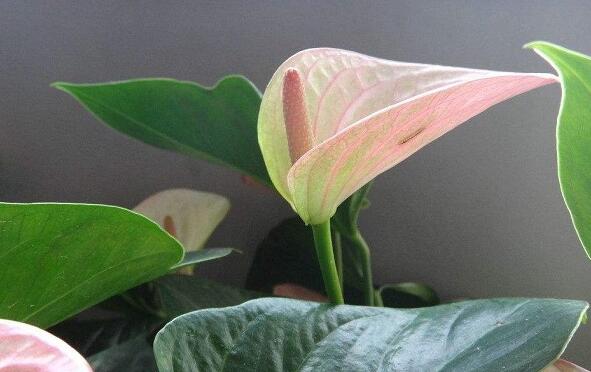What if the leaves of Golden Lotus turn yellow and dry? four tricks can keep the leaves green and green.
The leaves of Nelumbo nucifera look like lotus leaves and look chic and elegant. however, when planting, some flower friends will encounter its leaves yellowing, drying up, and so on, and they are often at a loss because they do not know what to do because they do not know what to do. What about the yellow and withered leaves? Here the editor will give you an analysis of common causes and solutions.
What if the leaves of Golden Lotus turn yellow and dry?
1. Leaf dehydration

If the lotus is not watered for a long time, or the air is always too dry, then the water contained in its leaves will be lost, resulting in dehydration and yellowing and drying up. If you encounter this situation, you can first think about whether you often do not water.
Solution: usually need reasonable watering, neither do not water for a long time, do not water too much at a time, according to the growth of the lotus, combined with the local climate to water flexibly, to ensure that the soil is moist but not stagnant water is the most basic principle.
2. Lack of nutrition
The demand for fertilizer is relatively low. If the soil is fertile, there is generally no yellowing of leaves, but some flower friends use less soil nutrients, coupled with very little fertilization at ordinary times. It will cause the lotus to dry up because of lack of nutrition.
Solution: it needs to be solved from many aspects. in addition to adding some base fertilizer to the soil when planting, we can also use rotten leaf soil and other more fertile soil, in addition, we also need reasonable fertilization at ordinary times. and the method can refer to the detailed introduction of how to apply fertilizer.
3. Sun exposure
We know that Trollius is a light-loving plant, and it has a certain phototaxis, but it can not be exposed to the sun in summer, otherwise it will not only yellowing and withering leaves, but also cause difficulties in flowering.
Solution: what if the leaves of Golden Lotus turn yellow and wither due to the sun exposure? Pay attention to reasonable control of light, in addition to summer, other seasons can let dry golden lotus grow in half-light environment, but summer needs reasonable shade, and when the temperature is high in spring and autumn, we should also pay attention to reduce the light at noon.
4. Soil partial acidity
Clematis can grow in slightly acidic soils, but cannot survive in sour soils such as red soil, which is deficient in magnesium, which is common in some parts of the south. In addition, it can not grow in alkaline soil.
Solution: the use of soil should be as neutral as possible. If it is a highly acidic soil, you can spray calcium magnesium phosphate fertilizer to adjust the PH value. In addition, when watering, pay attention to watering tap water for a few days before watering.
What's the matter with the yellowing of the leaves? what about the yellowing of the leaves?
The nature likes the mild climate, does not bear the severe cold and heat. The suitable temperature is 18 to 24 degrees Celsius. Can bear short-term 0 ℃ like warm and humid, overwintering temperature above 10 ℃. With the growth of stem vines, bamboo should be used in time to set up the stand and bind the branches. What happened to the yellowing of the leaves of Trollius chinensis? What if the leaves of Anoplophora acuminata turn yellow? The following wed114 wedding network editor brings you the details.
What's going on with the yellowing of the leaves of Clematis paniculata?
1. Too much water
After flowering, it is necessary to reduce watering to prevent the branches from growing. If excessive watering and poor drainage, the roots are vulnerable to wet rot, and the light ones with yellow leaves fall off seriously and the whole plant wilts and dies. If the basin soil stagnant water will cause the leaves to turn yellow. Dry lotus can be watered diligently, but there should be less moisture each time, so that the rate of water evaporation can not catch up with your watering speed.
2. Excessive fertilization
The concentration of fertilizer should not be too high, and the fertilizer should not be too much, otherwise it is easy to burn roots. After the root system is damaged, the leaves are naturally damaged. The fertilizer of dry golden lotus can choose natural fertilizer, and the manure of chicken, duck and goose is the best. No, you can dilute the special fertilizer for flowers when applying fertilizer.
3. Excessive illumination
The temperature and light in spring and autumn and winter is no problem for Golden Lotus, but the light in summer is too strong. Nelumbo nucifera is a kind of herb that is afraid of heat. if the light is too strong and the temperature is too high, it will dormancy, and the leaves will show signs of withering and yellowing. Therefore, it is necessary to give Clematis paniculata proper shade in summer.
4. Diseases and insect pests
Golden lotus common pests are red spiders and leaf moths, if there are pests, damage to the leaves, the leaves appear yellowing signs. To check carefully, the leaves have spider silk and eggs, and the back of the leaves should be observed carefully. When I found out. Kill it immediately, cut off the diseased leaves and burn them.
Generally speaking, there are many reasons for the yellowing of the leaves, including water, fertilizer, light and insect pests, so when you read the article, you should judge the reason for the yellowing of the leaves according to your own actual situation.
What if the leaves of Clematis paniculata turn yellow?
If it is due to too much watering or too little yellowing, then it should be noted that the water should be watered less after flowering, and that the drainage of flowerpots and soil must be good. Before flowering, we must adhere to the principle of not drying and watering thoroughly. Xiaobian's flowers are because of excessive watering. Although the leaves are not yellow, the branches grow crazy, which is particularly unsightly.
Summer is the dormant period of Clematis, do not excessive watering and fertilization during this period, it is also easy to make the leaves yellow, just put the potted plants in a cool, dry and ventilated place, it is very important not to let water in the soil basin, summer is the most concentrated period of yellowing leaves.
Take a close look at your dry lotus. If there is spider silk on your leaves, or if there are insects hidden in the inner page of the plant, the yellowing of the leaves must be caused by diseases and insect pests, and when it is serious, it can wither all the leaves. July-September is the season when the outbreak rate of diseases and insect pests is very high. this is when we have to prune the branches threatened by diseases and insect pests and clean them up. We can also spray insecticides three times a day or four times a day until the leaves turn green.
Honeysuckle language:
Dry golden lotus has a kind of flower saying that love is everywhere, but you are absent-minded. This tells us to be good at finding love in life, and to love with your heart. Love is a beautiful thing everywhere, hehe. There is another saying in the language of Hanjin lotus flowers that it is impossible to ask for things that can be encountered. It is good to be happy. In fact, Hua Yu often teaches us how to live and how to face life. There is also a word for patriotism in the language of Golden Lotus.
What if the leaves of Golden Lotus turn yellow and dry?
Nelumbo nucifera is a perennial semi-trailing or recumbent plant of the family Nelumbo nucifera. Plant height 30cm-70cm. Basal leaves long stipitate, leaf blade pentagonal, triplicate, bifid with a few lobules and acute teeth. Flowers solitary or 2-3 in Cymes, petals 5, sepals 8-19, yellow, elliptic-Obovate or Obovate, petals as long as sepals, narrowly striate. Some flower friends have encountered the phenomenon of yellowing of Clematis leaves before. generally speaking, there are many reasons for the yellowing of leaves, including water, fertilizer, light and insect pests. Let's take a look at the cause analysis and solutions for the yellowing and drying up of the leaves of Clematis paniculata.
The reason for the yellowing and drying of the leaves of Clematis paniculata 1. Yellow leaves: improper watering
Although it is called Nelumbo nucifera, it is relative to the lotus, but it is not a plant that likes drought. Watering requires alternation of dry and wet. The topsoil is not watered before it is dry, and it must be thoroughly watered when it is dry. In addition, it is necessary to reduce watering after flowering to prevent the branches from flourishing and growing. if excessive watering and poor drainage, the roots are vulnerable to wet rot, and the light ones with yellow leaves fall off seriously and the whole plant wilts and dies. (if the stagnant water in the basin soil will cause the leaves to turn yellow)
2. Yellow leaves of Nelumbo nucifera: low temperature
If the temperature is too low, it is best to keep it above 10 ℃, and the lower the temperature, the more necessary to control the watering times. And prevent cold wind blowing and heating, air-conditioning dry and hot wind blowing, otherwise it is very easy to cause leaf yellowing.
3 / Lotus leaf yellow: excessive fertilization
Excessive fertilization, although the need to apply fertilizer in the growth process, but excessive fertilizer will cause fertilizer damage. Especially when pouring fertilizer liquid, it is necessary to prevent the fertilizer liquid from splashing on the leaves.
4. Yellow leaves of Nelumbo nucifera: strong light
Light, this can not only talk about light, but also seasons, perennials, afraid of cold and heat, summer dormancy, can be put in a cool and ventilated place, stop fertilizing and less watering, Huangmei days do not let the basin soil stagnant water, do these basic can spend the summer. (to put it simply, dry golden lotus is afraid of heat, especially in summer, drought is easy to yellow leaves, but also because it is difficult to spend summer.)
5. The leaf yellow of Nelumbo nucifera: diseases and insect pests, red spiders harm, when the air is dry, it is easy to suffer from this pest, the method of prevention and control is to increase humidity, but also can spray mites special insecticides.
The solution to the yellowing and drying of the leaves of Trollius paniculata
In order to raise potted dry golden lotus well, first, we should select the reasonably prepared cultivation soil; second, we should strengthen the management of fertilizer and water during the growth period; third, we should ensure that there is enough sunshine.
The main results are as follows: 1. The loam mixed with 4 rotten leaf soil, 4 garden soil, 1 compost soil and 1 sandy soil should be selected.
2. During the growth period, the phenomena of long nodes and yellow leaves, small stems and fine leaves or luxuriant branches and leaves but few flowers often occur due to improper management of fertilizer and water. In the process of growth, the rotten bean cake water with a concentration of 20% is generally applied once a month; stop applying nitrogen fertilizer during flowering and apply 0 instead. 5% superphosphate or rotten chicken and duck dung water should be applied every half a month; after flower fade, 30% rotten bean cake water should be fertilized once to supplement the nutrients consumed by flowering.
3. Stop fertilizing in hot summer. The compound overwintering fertilizer was applied again at the end of autumn to enhance the cold resistance of the plant. Watering is a daily management work, watering times and amount of watering should be determined according to the weather and plant growth. In spring and autumn, it is generally watered once every other day and once a day in summer to maintain high air humidity. When the flower bud appears, the watering times should be reduced appropriately, but the amount of water should be increased each time to make the pot soil dry and wet. Watering should be reduced after flowering.
4. Handelia lanceolata is fond of sunshine, it should be placed in a place with sufficient sunshine in spring and autumn, proper shade in summer, room temperature in winter at about 15 ℃, sufficient sunshine, it can continue to grow and develop.
- Prev

What about the yellowing of taro leaves? pay attention to 5: 00 yellowing without worry / improper water and fertilizer is the key.
For the fruit taro, flower friends should be no stranger, its leaves are green, the white line above is clear in color, like a dancing butterfly, looks very lovely. But in the process of breeding, because of improper operation, many flower friends will cause the yellowing of taro leaves, which will seriously affect the ornamental.
- Next

What about the yellowing of pink palm leaves, 8 causes and solutions / can prevent yellowing of leaves
The leaves of pink palm are bright green and glossy, so it is not only a flowering plant, but also has a high viewing effect, but sometimes the leaves turn yellow because of improper cultivation methods or environmental discomfort.
Related
- Fuxing push coffee new agricultural production and marketing class: lack of small-scale processing plants
- Jujube rice field leisure farm deep ploughing Yilan for five years to create a space for organic food and play
- Nongyu Farm-A trial of organic papaya for brave women with advanced technology
- Four points for attention in the prevention and control of diseases and insect pests of edible fungi
- How to add nutrient solution to Edible Fungi
- Is there any good way to control edible fungus mites?
- Open Inoculation Technology of Edible Fungi
- Is there any clever way to use fertilizer for edible fungus in winter?
- What agents are used to kill the pathogens of edible fungi in the mushroom shed?
- Rapid drying of Edible Fungi

